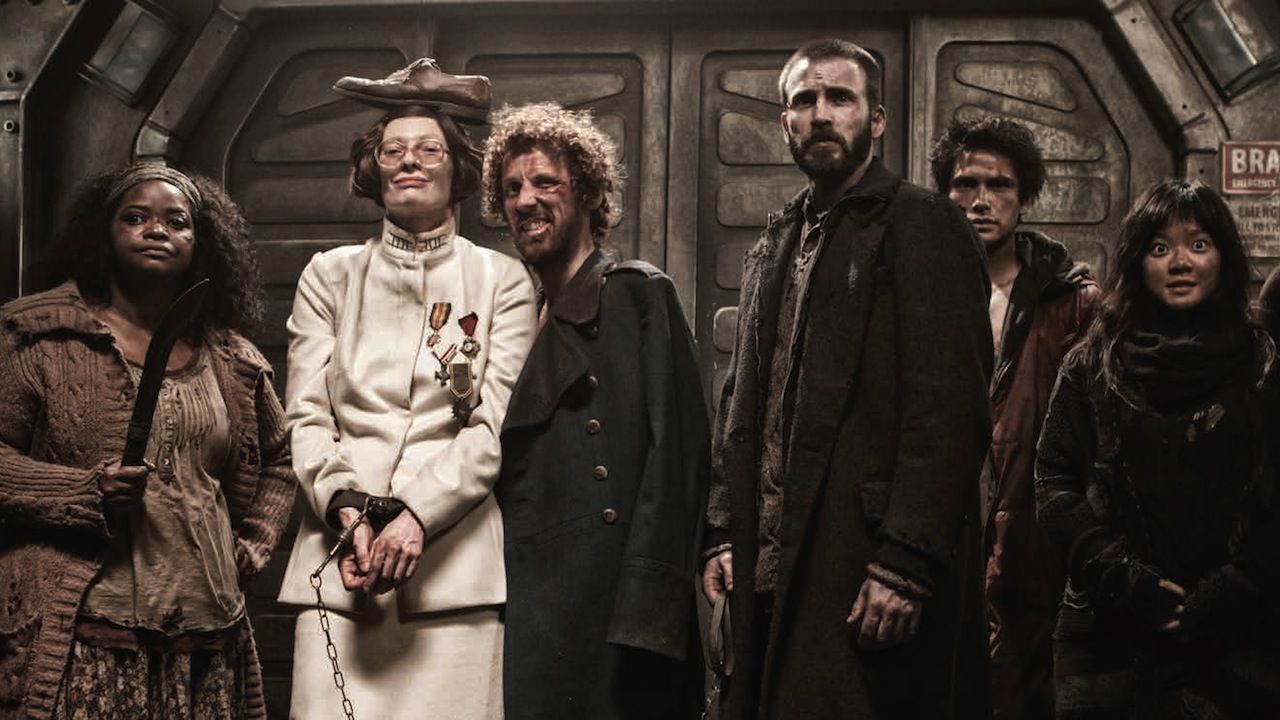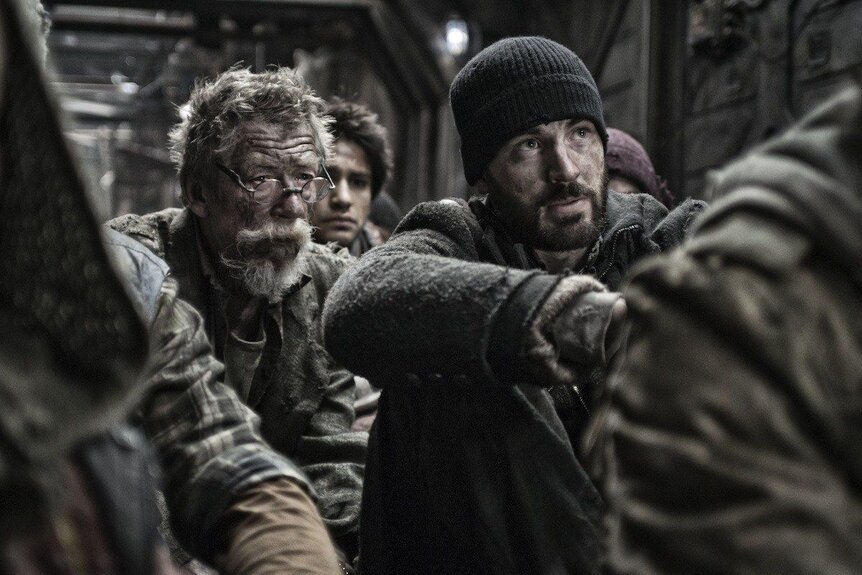Create a free profile to get unlimited access to exclusive videos, sweepstakes, and more!
How Bong Joon-ho revolutionized comic book adaptations with Snowpiercer

If you've been paying any attention to this year's Oscars buildup, you'll already recognize the work of Bong Joon-ho.
A South Korean visionary, the director has gifted cinephiles with psychological thrillers like Mother, surprisingly insightful monster movies like The Host, and his latest work, Parasite, a scathing takedown of social inequality disguised as a tense, often hilarious, crime caper. It's the last that's earning Bong so much buzz, positioning him to potentially make history should the film win the coveted Best Picture award at this year's ceremony. But Parasite isn't the first social justice allegory he's woven into his trademarked brand of Korean New Wave cinema.
In fact, eons ago — read: in 2013 — Bong quietly transformed the world of comic book movies by spinning another fatalistic yarn on the perils of society's class imbalance, a story of revolution and rebellion led by, who else, Captain America.
We're talking, of course, about Snowpiercer, the futuristic sci-fi flick Bong adapted just as the Marvel Cinematic Universe began to take shape. Chris Evans had recently suited up as the poster boy for patriotism, Steve Rogers, and graphic novels were being mined for blockbuster gold. Snowpiercer was a different breed of comic book fare, a film that took inspiration from the 1982 French graphic novel Le Transperceneige. It had all the makings of a classic, albeit darker-themed, genre film with a story that focused on the consequences of war, man's violent nature, and our penchant for self-destruction. But when Bong came on board, he gifted dystopian fans with a thought-provoking interpretation that continues to feel tailor-made for the times.
Both the graphic novel and the film imagine a frozen world in which the last remaining spark of humanity inhabits a high-speed locomotive constantly circling the earth. In the book, the world has entered an early ice age after humans — intent on destroying each other by making ill-fated grabs for power and resources — unleashed a chemical, CW-7, that altered Earth's atmosphere. In Bong's Snowpiercer, CW-7 was a last-ditch effort to save the planet after decades of abuse at the hands of its human residents.
While conflict and chaos inspired the events of the original story, Bong's take updates those themes. Sure, people are dangerous, but Mother Nature, when tested, is infinitely more deadly. To survive, what remains of humanity is forced aboard a train powered by a perpetual-motion engine. It's a hellish, high-speed Noah's Ark, a tin prison that magnifies the chasms between classes as the wealthy elite are positioned at the front of the train while the impoverished lower class lives in the tail. This is where our hero Curtis (a bearded, grimy Evans) lives in squalor with his group of soon-to-be-rebels played by Jamie Bell, Octavia Spencer, and John Hurt.
Life in the tail is full of disease, hunger, cramped suffering, and darkness. The masses exist on gelatinous cubes crafted from crushed cockroaches. They sleep on makeshift beds stacked five bodies high. Babies are cradled in trash barrels. Life is bleak and the rich — comfortably housed in spacious train cars filled with nightclubs, opium dens, underwater aquariums, and lush greenhouses — are entirely clueless to all of it. They eat fresh sushi and prime cuts of meat, they party and get high on an inhalant called Kronole, they worship the almighty "Engine" and the man who invented it, Wilford (Ed Harris).
While the novel partitions the train into three classes — and upper, middle, and lower — Bong magnifies the chasms between classes in a move that mirrors the issues plaguing our current social climate. The middle class may be disappearing in our world, but in Bong's, it's already extinct. And while the villains of the novel are the institutions and groups that perpetuate inequality, it's the system itself — a hierarchy modeled after Indian caste beliefs that your standing in the social order is preordained and cannot be changed — that serves as the monster Bong hopes to slay.
To do this, Curtis and his disenfranchised team of avengers launch a thrilling, bloody rebellion that moves them ever closer to the Eternal Engine and their chance to upset the power disparity. We've seen comic book films wade into social justice issues before — and certainly after — Snowpiercer (though none put such a darkly comedic, unsettling spin on them as Bong does), but it's the drawn-out battle sequences in the film's climactic third act that distinguishes it from any other adaptation you'll see in the genre world. We watch as Curtis hacks his way through propaganda-spewing elementary teachers and armored bodyguards, as he engages in shootouts that defy the laws of physics, as machetes and limbs fly in darkened train cars, blood spewing almost comically and allies dropping like flies. Bong isn't afraid to highlight the brutality and aggression of his heroes, and he takes each fight scene surprisingly seriously. There's no witty banter to lighten the mood, no offscreen deaths or CGI-powered space battles, there's just human beings inflicting damage on bodies made of flesh and bone, bone that cracks as it's broken, flesh that's ripped from muscles like paper from a cheap spiral notebook.
In a time when graphic novel and comic adaptations feel larger than life, with limitless universes and competing timelines, Bong's endgame battle is a contained marathon of carnage and kinetic fight sequences that proves world-ending themes don't have to be to scale.
And it ends, not with a victorious resolution, but with something more ambiguous: hope.
In Snowpiercer, once Curtis finally reaches the Engine, meets with Wilford, and discovers his entire rebellion was planned, that he's been chosen to uphold this system once Wilford passes on, the audience, along with our hero, is issued its final test. Is survival or self-determination more important? Is it better to stick to a known path — albeit one paved by fear and fascism — than to risk failure? Should we continue to subscribe to a belief system that places tangible value on human life depending on which train car you inhabit, which social group you were born into? Curtis makes that choice, and Bong rewards us with a final shot that continues to perplex audiences as two young kids, the sole survivors of the train's eventual destruction, step out into a new world. Life has begun to return, polar bears are roaming the snow-covered mountains, and we realize that it's nature, not humanity, that's eternal.
Whether the children survive on their own or not, what Bong does with Snowpiercer feels revolutionary for a comic adaptation. He refuses to adhere to the French novel's original grim ending in which the protagonist, apathetic to the suffering of the poor and only concerned with his own survival, becomes the Engine's caretaker when everyone else on the train dies. Instead, he demands more from Curtis, giving us a man motivated by guilt and a sense of justice. He demands more from the system that enslaves the people of the tail, positing that only a hard reset brought about by insurgency and, yes, violence can upset the current order. He offers a future for the next generation if the current one can earn it, but he doesn't give fans the neatly packaged win they've come to expect with comic book films. Heroes die, the villains aren't all bad, and in the end, people may just repeat history's mistakes.
It's realism — the same realism we see in his current Oscar contender Parasite — not fatalism, and it's a nice change for the sci-fi genre.



























